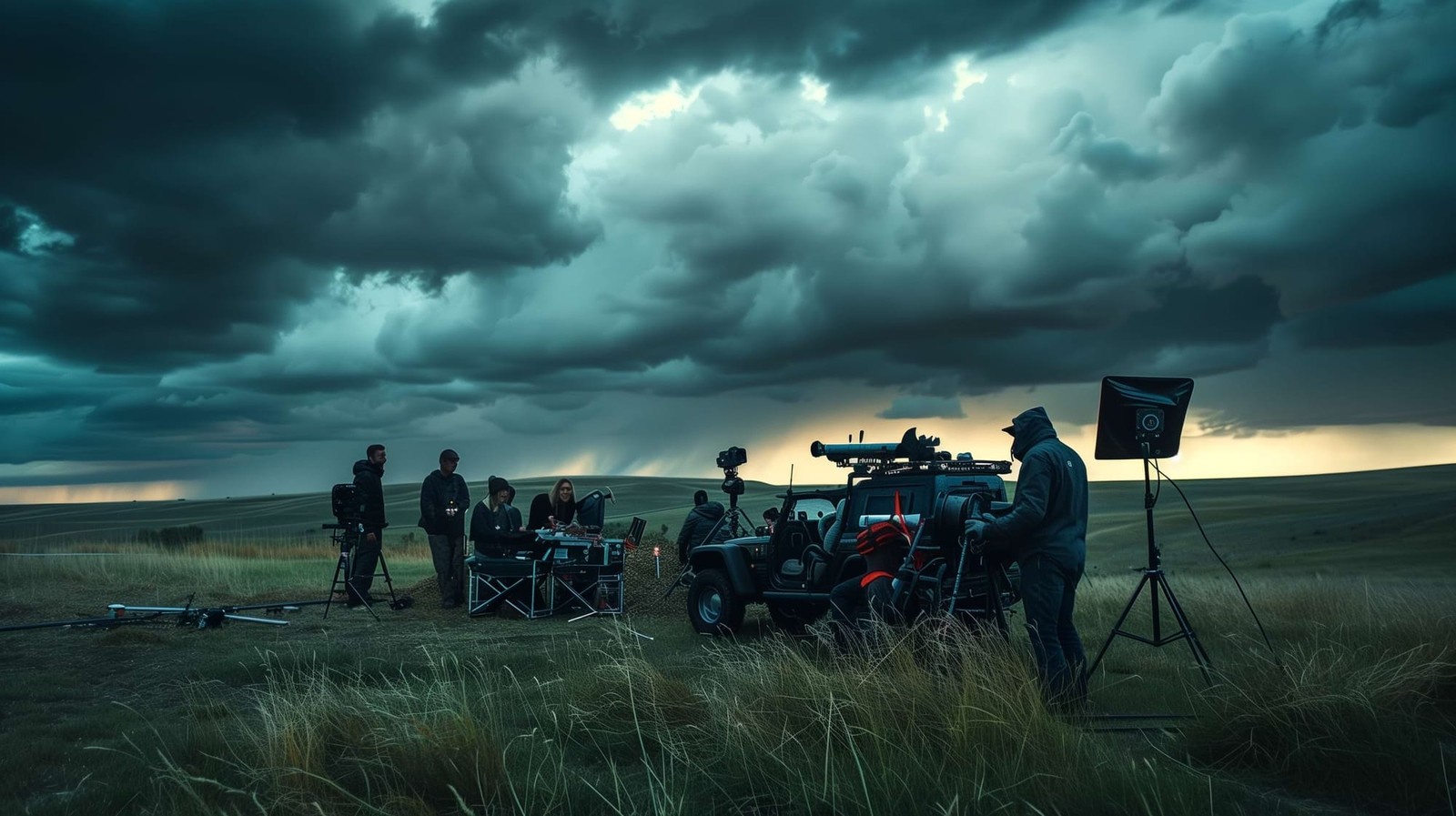The Impact of Weather on Shooting Schedules and How to Plan
Disruptions caused by weather are a threat in filmmaking, often leading to costly delays and frustrated crews. This article delves into the impact of weather on shooting schedules and provides strategies for planning and adapting to ensure your production stays on track, on budget, and on time.


Weather plays a critical role in film production, significantly impacting the shooting schedule and overall project efficiency. Considering meteorological conditions is not just a precaution, but a necessity in the film production process. Unpredictable weather can disrupt carefully planned outdoor scenes, affect lighting conditions, and even pose a threat to the safety of actors and crew. By anticipating and adapting to weather conditions, producers can minimize costly delays, ensure continuity of filming, and guarantee the well-being of everyone involved. This proactive approach to managing weather conditions in a filming schedule can make the difference between a smooth production and a production plagued by setbacks and budget overruns.
Understanding the Impact of Weather on Shooting Schedules
The impact of weather on shooting schedules manifests in various ways. Outdoor scenes are particularly vulnerable, as they rely heavily on specific lighting conditions and clear skies. A cloudy day can drastically alter the visual tone of a scene intended for bright sunlight. Similarly, wind can interfere with sound recording, requiring additional post-production work or reshoots.
Key weather impacts include:
🌥️ Lighting changes affecting continuity
💨 Sound quality issues from wind or rain
⚠️ Safety concerns for cast and crew
🌡️ Equipment malfunctions due to extreme temperatures
🚗 Location access problems

Managing Weather-related Delays ⏰
It requires a combination of preparation, flexibility, and creative problem-solving. Production teams often build buffer days into schedules to account for potential weather issues. They may also prioritize indoor scenes during seasons prone to inclement weather, allowing outdoor shots to be rescheduled as needed.
In cases where weather-related delays are unavoidable, directors and cinematographers must be prepared to adapt quickly. This might involve rewriting scenes, utilizing visual effects to simulate desired weather conditions, or creatively repurposing available locations to maintain production momentum.
📖 Read more about planning strategies for filming schedules during sudden events (not just weather) here.
Using Weather Forecasts in Production Planning
In today's data-driven world, weather forecasting has evolved from a guessing game to a sophisticated science. As a filmmaker, leveraging this technology is not just smart – it's essential for proactive scheduling adjustments for weather.
Modern Weather Forecasting Tools Offer:
🕐 Hourly predictions up to 15 days in advance
💧 Detailed reports on cloud cover, wind speed, and precipitation
🌎 Historical weather data for location scouting
Integrating these forecasts into your production planning can save you thousands of dollars and countless headaches. For instance, by analyzing weather patterns, you might discover that shooting your beach scene in October rather than July reduces the risk of tropical storms by 60%.

Strategies for Planning for Weather Disruptions ☔
While sunshine and blue skies are ideal, crafting airtight backup plans for weather issues ensures your production sails through storms, both literal and metaphorical.
Effective weather management in film production is an art form, and here's how you can master it:
- Flexible Location Scouting: Always have indoor alternatives for outdoor scenes. A well-prepared producer might secure a backup studio space that can be quickly transformed to match the outdoor aesthetic.
- Scene Shuffling: Organize your shot list so that weather-dependent scenes can be easily swapped with indoor scenes. This requires a keen understanding of your script and the ability to maintain narrative continuity despite out-of-sequence shooting.
- Technological Solutions: Invest in weather-resistant equipment. From rain covers for cameras to specialized lighting for overcast days, the right gear can keep you shooting when others are forced to pack up.
- Creative Problem-Solving: Sometimes, embracing the weather can lead to unexpected brilliance. For example, films like "Twister" (1996) or "The Day After Tomorrow" (2004) featured scenes shot in extreme weather conditions, which made the visuals more authentic and emotional.
Effective Communication and Film Crew Management ️📣
Emergency planning for on-set issues keeps your crew safe and the production rolling, even when faced with unexpected challenges.
Clear communication becomes your most valuable asset when the weather throws a wrench in your plans.
📢 Keeping everyone informed about potential disruptions and contingency plans helps maintain morale and ensures everyone is prepared to adapt. Techniques like walkie-talkies or production apps can facilitate efficient communication during weather changes, allowing for quick adjustments to the shooting schedule.
👑 Establish who makes the final call on weather-related decisions to avoid confusion and delays.
🛡️ Always prioritize crew safety in your decision-making process. A well-rested, secure crew is more efficient in the long run.
Remember, your ability to handle weather disruptions with grace and efficiency will earn you respect and loyalty from your crew. It's not just about managing schedules; it's about leading a team through challenges.

🎬 Case Studies and Practical Examples in Outdoor Shooting Challenges
Let's look at how some productions turned potential weather disasters into triumphs:
"Jurassic Park" (1993)
"They herded us into a ballroom, all the cast and crew, a few hours before Hurricane Iniki hit us," wrote actor Sam Neill. "Iniki was a Category 4 hurricane and it absolutely wrecked the island, including all our sets".
When Hurricane Iniki hit Hawaii during filming, Spielberg's team quickly adapted. The film crew was warned of the impending Hurricane, and the safety of the crew members was made a priority. In order not to stop the production of the film, filming was moved to Los Angeles to the studio.
"Mad Max: Fury Road" (2015)
"What was meant to be flat, red earth is now a flower garden," told Miller. "And the great salt lakes which you can drive across are now full of pelicans and fish."
Unexpected rains turned their desert location into a flower field. Instead of delaying, the film crew moved locations and used the new environment to their advantage.
"The Revenant" (2015)
“We had weather challenges,” said Brad Weston, president and CEO of backer New Regency. “This was a tough movie."
Faced with a lack of snow, the production moved to the southern tip of Argentina to find the right conditions, showcasing the importance of flexibility in location choices.
These examples demonstrate that weather challenges can be overcome and even used to enhance the final product with the right planning tools and a flexible mindset.
Weathering the Storm with Filmustage
Weather will always be an unpredictable factor in film production, but with the right tools and strategies, it doesn't have to be an insurmountable obstacle.
Filmustage offers a comprehensive solution to weather-related planning challenges, integrating script analysis, breakdown, synopsis, and scheduling into one platform, helping you identify potential conflicts and make informed decisions.
For example, using the Scheduling Tool, you can easily create shooting schedules, taking into account the potential risks calculated by the Script Analysis Tool. And if, nevertheless, bad weather overtakes you, Filmustage will generate a new filming schedule taking into account the changes.
🌈 Don't let the weather dictate the success of your production. Take control with Filmustage and turn potential disruptions into opportunities for creativity and efficiency.
From Breakdown to Budget in Clicks
Save time, cut costs, and let Filmustage’s AI handle the heavy lifting — all in a single day.